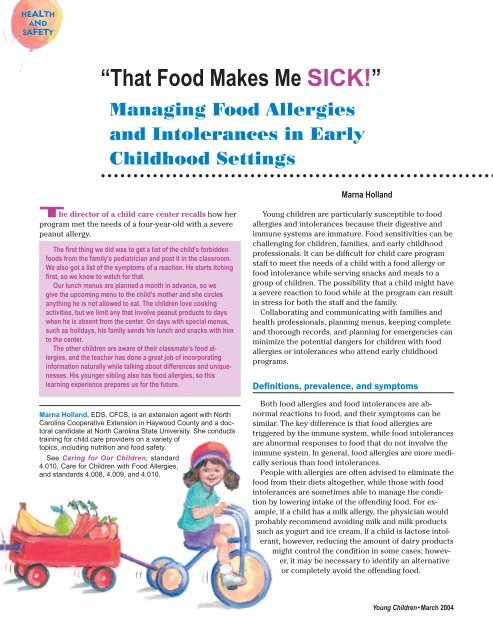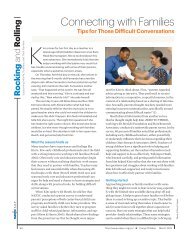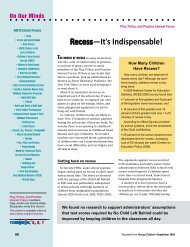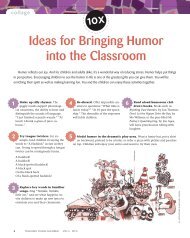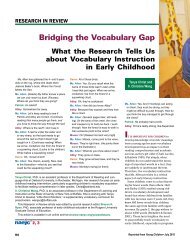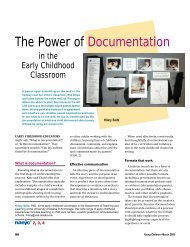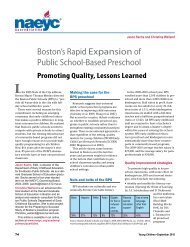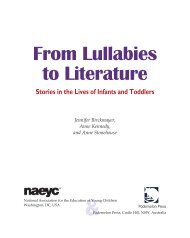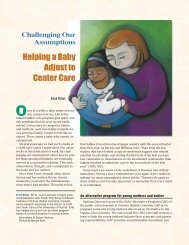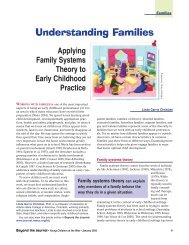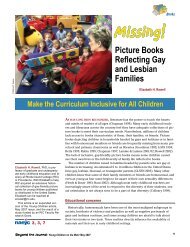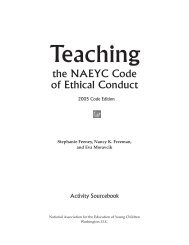That Food Makes Me SICK! - National Association for the Education ...
That Food Makes Me SICK! - National Association for the Education ...
That Food Makes Me SICK! - National Association for the Education ...
You also want an ePaper? Increase the reach of your titles
YUMPU automatically turns print PDFs into web optimized ePapers that Google loves.
HEALTH<br />
AND<br />
SAFETY<br />
“<strong>That</strong> <strong>Food</strong> <strong>Makes</strong> <strong>Me</strong> <strong>SICK</strong>!”<br />
Managing <strong>Food</strong> Allergies<br />
and Intolerances in Early<br />
Childhood Settings<br />
T<br />
he director of a child care center recalls how her<br />
program met <strong>the</strong> needs of a four-year-old with a severe<br />
peanut allergy.<br />
The first thing we did was to get a list of <strong>the</strong> child’s <strong>for</strong>bidden<br />
foods from <strong>the</strong> family’s pediatrician and post it in <strong>the</strong> classroom.<br />
We also got a list of <strong>the</strong> symptoms of a reaction. He starts itching<br />
first, so we know to watch <strong>for</strong> that.<br />
Our lunch menus are planned a month in advance, so we<br />
give <strong>the</strong> upcoming menu to <strong>the</strong> child’s mo<strong>the</strong>r and she circles<br />
anything he is not allowed to eat. The children love cooking<br />
activities, but we limit any that involve peanut products to days<br />
when he is absent from <strong>the</strong> center. On days with special menus,<br />
such as holidays, his family sends his lunch and snacks with him<br />
to <strong>the</strong> center.<br />
The o<strong>the</strong>r children are aware of <strong>the</strong>ir classmate’s food allergies,<br />
and <strong>the</strong> teacher has done a great job of incorporating<br />
in<strong>for</strong>mation naturally while talking about differences and uniquenesses.<br />
His younger sibling also has food allergies, so this<br />
learning experience prepares us <strong>for</strong> <strong>the</strong> future.<br />
Marna Holland, EDS, CFCS, is an extension agent with North<br />
Carolina Cooperative Extension in Haywood County and a doctoral<br />
candidate at North Carolina State University. She conducts<br />
training <strong>for</strong> child care providers on a variety of<br />
topics, including nutrition and food safety.<br />
See Caring <strong>for</strong> Our Children, standard<br />
4.010, Care <strong>for</strong> Children with <strong>Food</strong> Allergies,<br />
and standards 4.008, 4.009, and 4.010.<br />
Marna Holland<br />
Young children are particularly susceptible to food<br />
allergies and intolerances because <strong>the</strong>ir digestive and<br />
immune systems are immature. <strong>Food</strong> sensitivities can be<br />
challenging <strong>for</strong> children, families, and early childhood<br />
professionals. It can be difficult <strong>for</strong> child care program<br />
staff to meet <strong>the</strong> needs of a child with a food allergy or<br />
food intolerance while serving snacks and meals to a<br />
group of children. The possibility that a child might have<br />
a severe reaction to food while at <strong>the</strong> program can result<br />
in stress <strong>for</strong> both <strong>the</strong> staff and <strong>the</strong> family.<br />
Collaborating and communicating with families and<br />
health professionals, planning menus, keeping complete<br />
and thorough records, and planning <strong>for</strong> emergencies can<br />
minimize <strong>the</strong> potential dangers <strong>for</strong> children with food<br />
allergies or intolerances who attend early childhood<br />
programs.<br />
Definitions, prevalence, and symptoms<br />
Both food allergies and food intolerances are abnormal<br />
reactions to food, and <strong>the</strong>ir symptoms can be<br />
similar. The key difference is that food allergies are<br />
triggered by <strong>the</strong> immune system, while food intolerances<br />
are abnormal responses to food that do not involve <strong>the</strong><br />
immune system. In general, food allergies are more medically<br />
serious than food intolerances.<br />
People with allergies are often advised to eliminate <strong>the</strong><br />
food from <strong>the</strong>ir diets altoge<strong>the</strong>r, while those with food<br />
intolerances are sometimes able to manage <strong>the</strong> condition<br />
by lowering intake of <strong>the</strong> offending food. For example,<br />
if a child has a milk allergy, <strong>the</strong> physician would<br />
probably recommend avoiding milk and milk products<br />
such as yogurt and ice cream. If a child is lactose intolerant,<br />
however, reducing <strong>the</strong> amount of dairy products<br />
might control <strong>the</strong> condition in some cases; however,<br />
it may be necessary to identify an alternative<br />
or completely avoid <strong>the</strong> offending food.<br />
Young Children • March 2004
The most common foods to cause<br />
allergies <strong>for</strong> children are milk, eggs,<br />
peanuts, soybeans, tree nuts (such<br />
as pecans and walnuts), wheat, fish,<br />
and shellfish.<br />
The most common foods to cause allergies <strong>for</strong> children<br />
are milk, eggs, peanuts, soybeans, tree nuts (such<br />
as pecans and walnuts), wheat, fish, and shellfish (Duyff<br />
2002). In addition, young children might be allergic to<br />
oranges, chocolate, legumes, rice, and meats—including<br />
beef, pork, and chicken (Berman & Fromer<br />
1997).<br />
The symptoms of an allergic reaction may<br />
include itching and swelling of <strong>the</strong> lips and<br />
mouth, hives, eczema, sneezing, runny nose,<br />
difficulty breathing, nausea, vomiting, abdominal<br />
cramping, and diarrhea (Bruton 1998).<br />
During an anaphylactic response—<strong>the</strong> most<br />
severe type of allergic reaction—different<br />
systems of <strong>the</strong> body react simultaneously.<br />
Symptoms appear and progress quickly and<br />
may include severe itching, swelling of <strong>the</strong><br />
throat, difficulty in breathing, sweating, rapid<br />
or irregular heartbeat, low blood pressure,<br />
nausea, diarrhea, loss of consciousness, cardiac<br />
arrest, and shock (Duyff 2002). Anaphylactic<br />
reactions require immediate medical<br />
treatment; <strong>the</strong>y can be fatal. The most common<br />
anaphylaxis-causing food allergens are<br />
tree nuts, eggs, peanuts, and shellfish (Duyff<br />
2002).<br />
Casey Sills<br />
<strong>Food</strong> intolerances occur when a person’s body has an<br />
abnormal, but not allergic, reaction to a food or food additives<br />
such as sulfites (used as food preservatives) or<br />
food colorings. Possible causes include deficiency of an<br />
enzyme or reactions to compounds, additives, or naturally<br />
occurring substances in food (Story, Holt, & Sofka<br />
2000; CDE n.d.). Symptoms of food intolerance, which<br />
tend to be unpleasant but not as dangerous as food<br />
allergies, include nausea, abdominal pain, gas, stomach<br />
cramps, bloating, vomiting, diarrhea, headaches, and<br />
irritability. <strong>Food</strong> intolerance is more common than food<br />
allergy. Lactose intolerance—<strong>the</strong> inability to digest <strong>the</strong><br />
milk sugar lactose—is <strong>the</strong> most prevalent.<br />
According to <strong>the</strong> American Dietetic <strong>Association</strong> (ADA),<br />
thirty to fifty million Americans suffer from lactose intolerance<br />
(1996, n.p.). A gastrointestinal virus that temporarily<br />
destroys <strong>the</strong> enzyme that breaks down lactose<br />
usually causes lactose intolerance in infants. It may take<br />
an infant several days to several months to recover completely,<br />
depending on <strong>the</strong> severity of <strong>the</strong> virus (Bruton<br />
1998).<br />
Ano<strong>the</strong>r common food intolerance is sulfite sensitivity.<br />
Persons with asthma can have severe reactions to<br />
sulfites (NIAID n.d.). Sulfites are potentially found in fruit<br />
juice, dried fruits, gelatin, and instant or frozen potato<br />
products (Duyff 2002), all of which may be on <strong>the</strong> menus<br />
in child care facilities.<br />
Cultural background appears to be a factor in food<br />
intolerances, particularly lactose intolerance. According<br />
to <strong>the</strong> ADA, lactose intolerance affects approximately<br />
90 percent of Asian Americans and 75 percent of African<br />
Americans, Native Americans, Jews, and Hispanics in <strong>the</strong><br />
United States (1996, n.p.).<br />
Picture Books about<br />
<strong>Food</strong> Allergies and Intolerances<br />
Some books focus on allergies to specific foods, such as nuts or<br />
seafood, o<strong>the</strong>rs on coping with food allergies.<br />
Allie <strong>the</strong> Allergic Elephant. 2002. Nicole Smith, ages 3–6.<br />
No Lobster, Please! 2003. Robyn Rogers, ages 4–7.<br />
No Nuts <strong>for</strong> <strong>Me</strong>. 1995. Aaron Zevy, ages 4–8.<br />
The Peanut Butter Jam. 2001. Elizabeth S. Nassau, ages 5–8.<br />
Taking <strong>Food</strong> Allergies to School. 1999. Ellen Weiner, ages 6–8.<br />
The <strong>Food</strong> Allergy and Anaphylaxis Network at www.foodallergy.<br />
org offers a series of picture books about Alexander, a peanutallergic<br />
elephant. The books describe how Alexander copes with<br />
situations such as birthday parties, eating out, and holidays.<br />
Supplementary materials are also available.<br />
Young Children • March 2004 43
HEALTH<br />
AND<br />
SAFETY<br />
Coping strategies <strong>for</strong> child care centers<br />
The following strategies can help early childhood<br />
educators safely address food allergies and intolerances<br />
with sensitivity so that no children feel spotlighted or<br />
excluded from any program activity.<br />
Develop written policies<br />
An initial step in addressing a child’s food allergies is<br />
to request a doctor’s statement that gives <strong>the</strong> specifics<br />
of <strong>the</strong> condition, acceptable<br />
food substitutions,<br />
and instruction<br />
in <strong>the</strong> event <strong>the</strong> child<br />
is exposed to <strong>the</strong> problem<br />
food. A written<br />
policy should define<br />
<strong>the</strong> family’s and <strong>the</strong><br />
teacher’s individual<br />
responsibilities regarding<br />
<strong>the</strong> child’s food<br />
allergy.<br />
A list of children and<br />
<strong>the</strong>ir reactive foods<br />
should be maintained<br />
in <strong>the</strong> center’s food<br />
preparation and serving<br />
areas where it<br />
is accessible to all<br />
adults involved in<br />
feeding children.<br />
© Lois Main<br />
O<strong>the</strong>r suggestions<br />
include<br />
obtaining parental<br />
authorization<br />
and providing<br />
appropriate training<br />
to administer<br />
emergency allergy<br />
medication. Barber<br />
(2001) advocates<br />
making plans that cover<br />
celebrations (such as birthdays),<br />
snacks, and field trips. These<br />
plans might call <strong>for</strong> an allergen-free cupcake to be<br />
dropped off by <strong>the</strong> child’s family be<strong>for</strong>e <strong>the</strong> party or <strong>for</strong><br />
<strong>the</strong> family to provide extra medication to be sent along<br />
<strong>for</strong> field trips.<br />
Thorough documentation is essential to managing a<br />
child’s allergies in child care. State licensing and health<br />
agencies can recommend what in<strong>for</strong>mation about allergies<br />
needs to be maintained in <strong>the</strong> child’s records. These<br />
recommendations would also apply to food intolerances.<br />
A list of children and <strong>the</strong>ir reactive foods<br />
should be maintained in <strong>the</strong> center’s food<br />
preparation and serving areas where it<br />
is accessible to all adults involved<br />
in feeding children.<br />
Establish written emergency procedures<br />
It will be easier <strong>for</strong> staff to respond to an emergency<br />
if <strong>the</strong>re is a plan that tells everyone what to do. Staff<br />
should be trained by medical professionals on how to<br />
administer emergency medications, including epinephrine,<br />
a treatment <strong>for</strong> anaphylactic reaction often delivered<br />
through an injector called an EpiPen. The content<br />
and delivery of training should comply with state regulations<br />
about food allergies in child care settings.<br />
Plan menus that consider food<br />
allergies and intolerances<br />
Careful menu planning is essential<br />
in managing food allergies and<br />
intolerances. When many foods<br />
are eliminated or severely limited,<br />
a child’s diet may be deficient in<br />
nutrients that would normally be<br />
supplied by <strong>the</strong> offending foods.<br />
For example, a child with a dairy<br />
allergy may be at risk <strong>for</strong> a calcium<br />
deficiency, while a child with a<br />
wheat allergy may need more iron<br />
(Story, Holt, & Sofka 2000). To <strong>the</strong><br />
extent possible, children with food<br />
allergies and intolerances should<br />
eat foods similar to those served to<br />
<strong>the</strong> o<strong>the</strong>r children to lessen feelings<br />
of difference and isolation.<br />
Allergy-specific cookbooks<br />
can be helpful <strong>for</strong> guiding<br />
those preparing meals <strong>for</strong><br />
allergic children. A wheat-free<br />
cookbook can aid a center’s<br />
kitchen staff struggling to<br />
safely feed a wheat-allergic<br />
child. <strong>Food</strong> label ingredient<br />
lists also yield useful in<strong>for</strong>mation.<br />
(A packaged meat loaf may<br />
include eggs, which would make it<br />
off-limits <strong>for</strong> a child with egg allergies.)<br />
Allergens are listed in a number of<br />
different ways on food labels, but <strong>the</strong>y may<br />
To <strong>the</strong> extent possible, children with<br />
food allergies and intolerances should<br />
eat foods similar to those served to <strong>the</strong><br />
o<strong>the</strong>r children.<br />
Young Children • March 2004
e hidden. For example, a milk allergy requires not only<br />
searching <strong>the</strong> label <strong>for</strong> “milk” but also <strong>for</strong> “whey,” “nonfat<br />
milk solids,” and “lactose.”<br />
Make sure snack and mealtimes are safe<br />
Provide close supervision during meals and snacks so<br />
<strong>the</strong> child with <strong>the</strong> food allergy or intolerance does not<br />
have contact with offending foods or drinks or touch<br />
plates or utensils that might contain traces of <strong>the</strong> allergen.<br />
Using different colored tableware (cups, bowls,<br />
plates, utensils) <strong>for</strong> each child makes it is easier to spot<br />
when one child has traded with ano<strong>the</strong>r (Bruton 1998).<br />
Because young children are encouraged to share with<br />
each o<strong>the</strong>r during o<strong>the</strong>r situations, <strong>the</strong>y may need reminders<br />
of why <strong>the</strong>y may not trade or give food to each<br />
o<strong>the</strong>r at mealtimes.<br />
Educators face <strong>the</strong> challenge of watching what <strong>the</strong><br />
child eats while also encouraging developmentally appropriate<br />
self-help skills. It is extremely important to<br />
model and teach coping and management skills. Preschool<br />
children with life-threatening food allergies must<br />
know what foods <strong>the</strong>y can and cannot eat and how and<br />
what to tell <strong>the</strong> teacher when <strong>the</strong>y are having a reaction<br />
to food. It is also important <strong>for</strong> <strong>the</strong>m to understand that,<br />
in case of an emergency, <strong>the</strong>ir medication is with or near<br />
<strong>the</strong>m at all times (BCMCF 1999).<br />
Depending on a child’s type of food allergy, <strong>the</strong> center<br />
may need to in<strong>for</strong>m all families in <strong>the</strong> class that a child<br />
has a specific condition. In particular, peanut and seafood<br />
allergies fall into this category because children<br />
can have a reaction just by being near those food products.<br />
For a child who is peanut allergic, something as<br />
simple as a nearby child eating a snack of peanut butter<br />
Review recipes, plans, and labels <strong>for</strong> activities<br />
According to Barber, “Counting pumpkin seeds,<br />
M&Ms, or sunflower seeds may be a good way to teach<br />
number concepts, but to a peanut- or seed-allergic child,<br />
even handling <strong>the</strong>se foods may be dangerous” (2001,<br />
220). Classroom cooking activities must be monitored<br />
closely. Children with food allergies may not be able to<br />
eat <strong>the</strong> finished product after a group cooking activity,<br />
but <strong>the</strong>y can participate in o<strong>the</strong>r ways, such as ga<strong>the</strong>ring<br />
bowls and utensils, arranging table settings, pouring<br />
drinks, or photographing <strong>the</strong> activity. Have <strong>the</strong> child<br />
who has <strong>the</strong> allergy wear plastic gloves so <strong>the</strong> ingredients<br />
don’t touch his or her skin (Weiner 1999). Even<br />
touching a surface having small amounts of offending<br />
food on it may cause some children to develop symptoms.<br />
Be<strong>for</strong>e reuse <strong>for</strong> o<strong>the</strong>r activities, thoroughly clean<br />
food containers, such as egg cartons or yogurt cups, to<br />
protect children with severe allergies.<br />
Adopt a team approach<br />
Successful management of food intolerances and allergies<br />
requires a cooperative, team approach. The child<br />
who has <strong>the</strong> allergy, <strong>the</strong> family, all staff (including substitutes),<br />
<strong>the</strong> physician, o<strong>the</strong>r health care providers<br />
(nurse or dietitian), and <strong>the</strong> o<strong>the</strong>r children and <strong>the</strong>ir<br />
families all have roles to play.<br />
As children get older, <strong>the</strong>y become increasingly<br />
aware of what can happen if <strong>the</strong>y eat <strong>for</strong>bidden foods<br />
and are more able to help regulate <strong>the</strong>ir diets. Un<strong>for</strong>tunately,<br />
young children may feel separated and isolated<br />
from peers during meals and snack times. It can help<br />
to maintain a matter-of-fact approach and encourage <strong>the</strong><br />
child to take greater responsibility <strong>for</strong> choosing appropriate<br />
foods (Berman & Fromer 1997).<br />
© Lois Main<br />
Educators face <strong>the</strong> challenge of watching<br />
what <strong>the</strong> child eats while also encouraging<br />
developmentally appropriate<br />
self-help skills.<br />
Young Children • March 2004 45
HEALTH<br />
AND<br />
SAFETY<br />
and crackers from home can result in a medical emergency.<br />
The program or <strong>the</strong> family of <strong>the</strong> child with <strong>the</strong> allergy<br />
can send a letter to <strong>the</strong> o<strong>the</strong>r families detailing <strong>the</strong><br />
child’s allergies and what foods need to be eliminated<br />
from <strong>the</strong> environment (Barber 2001).<br />
Taking a positive, proactive approach in in<strong>for</strong>ming<br />
families who need to know about <strong>the</strong> allergy should<br />
make <strong>the</strong> situation less stressful. It is also important to<br />
teach <strong>the</strong> rest of <strong>the</strong> children in <strong>the</strong> class not to share<br />
Print<br />
Resources <strong>for</strong><br />
Early Childhood Educators<br />
Barber, M. 2001. The parent’s guide to food allergies. New York:<br />
Henry Holt.<br />
Breault, J. 1999. Special foods <strong>for</strong> special kids: A training tool<br />
<strong>for</strong> child care providers on feeding children with special needs.<br />
Topeka: <strong>National</strong> <strong>Food</strong> Service Management Institute and<br />
Kansas State University.<br />
Bruton, S., ed. 1998. Every little bite counts: Supporting young<br />
children with special needs at mealtime. Sacramento: Cali<strong>for</strong>nia<br />
Department of <strong>Education</strong>.<br />
A guide to feeding young children with special needs: For early<br />
childhood programs, families, and anyone responsible <strong>for</strong> <strong>the</strong><br />
feeding of young children. 1995. Phoenix: Arizona Department<br />
of Health Services.<br />
NFSMI/UM (<strong>National</strong> <strong>Food</strong> Service Management Institute/University<br />
of Mississippi). 2003. From <strong>the</strong> trainer’s tablet: Lessons<br />
<strong>for</strong> family/home child care providers: <strong>Food</strong> intolerance and<br />
allergies. University, MS: Authors. Online: www. nfsmi.org/<br />
In<strong>for</strong>mation/cclessons/allergies.pdf<br />
USDA (United States Department of Agriculture). 2000. Building<br />
blocks <strong>for</strong> fun and healthy meals: A menu planner <strong>for</strong> <strong>the</strong> Child<br />
and Adult Care <strong>Food</strong> Program. Washington, DC: Author.<br />
Web sites<br />
Allergies and <strong>Food</strong> Sensitivities, <strong>Food</strong> and Nutrition In<strong>for</strong>mation<br />
Center. www.nal.usda.gov/fnic/etext/000004.html<br />
American Academy of Allergy Asthma and Immunology. www.<br />
aaaai.org<br />
Asthma and Allergy Foundation of America. www.aafa.org<br />
Child Care Nutrition Resource System. www.nal.usda.gov/<br />
childcare/index.html<br />
The <strong>Food</strong> Allergy and Anaphylaxis Network. www.foodallergy.<br />
org<br />
Life-Threatening <strong>Food</strong> Allergies in School and Child Care Settings.<br />
www.healthservices.gov.bc.ca/cpa/publications/<br />
food_allergies.pdf<br />
<strong>National</strong> <strong>Food</strong> Service Management Institute/University of<br />
Mississippi. www.nfsmi.org/In<strong>for</strong>mation/Newsletters<br />
Mary has her own special milk so that<br />
she won’t get a tummy ache and she can<br />
stay healthy.<br />
food with <strong>the</strong> child who has <strong>the</strong> food allergy or intolerance.<br />
Bruton suggests, “Explain briefly and simply why a<br />
child is not able to share some of <strong>the</strong> same foods. For example,<br />
‘Mary has her own special milk so that she won’t<br />
get a tummy ache and she can stay healthy’” (1998, 95).<br />
Conclusion<br />
Effective management of food allergies and intolerances<br />
in child care settings includes education <strong>for</strong> staff and<br />
families, appropriate written policies, good communication,<br />
and thoughtful planning and preparation. Teachers<br />
need to be knowledgeable about food allergies; communicate<br />
regularly with families, children, and health care<br />
providers; plan menus accordingly; and prepare to deal<br />
with emergencies. This sound preparation will reduce<br />
stress and ensure that <strong>the</strong> needs of <strong>the</strong> child and family<br />
are met in safe, sensitive, and appropriate ways.<br />
References<br />
ADA (American Dietetic <strong>Association</strong>). 1996. Lactose intolerance.<br />
Chicago: Author. Online: www.eatright.org/Public/Nutrition In<strong>for</strong>mation/92_nfs43.cfm.<br />
Barber, M. 2001. The parent’s guide to food allergies. New York:<br />
Henry Holt.<br />
BCMCF (British Columbia Ministry <strong>for</strong> Children and Families). 1999.<br />
Life threatening food allergies in school and child care settings.<br />
British Columbia, CAN: Author. Online: www.healthservices. gov.<br />
bc.ca/cpa/publications/food_allergies.pdf.<br />
Berman, C., & J. Fromer. 1997. <strong>Me</strong>als without squeals. Boulder, CO:<br />
Bull Publishing.<br />
Bruton, S., ed. 1998. Every little bite counts: Supporting young children<br />
with special needs at mealtime. Sacramento: Cali<strong>for</strong>nia Department<br />
of <strong>Education</strong>.<br />
CDE (Cali<strong>for</strong>nia Department of <strong>Education</strong>). n.d. <strong>Food</strong> allergies. Sacramento,<br />
CA: Author. Online: www.cde.ca.gov/nsd/nets/news/nt_1.<br />
htm.<br />
Duyff, R. 2002. American Dietetic <strong>Association</strong> complete food and<br />
nutrition guide. 2d ed. Hoboken, NJ: John Wiley.<br />
NIAID (<strong>National</strong> Institute of Allergy and Infectious Diseases). n.d.<br />
<strong>Food</strong> allergy and intolerances. Washington, DC: U.S. Department<br />
of Health and Human Services. Online: www.niaid.nih.gov/factsheets/food.htm.<br />
Story, M., K. Holt, & D. Sofka. 2000. Bright futures in practice: Nutrition.<br />
Arlington, VA: <strong>National</strong> Center <strong>for</strong> <strong>Education</strong> in Maternal and<br />
Child Health.<br />
Weiner, E. 1999. Taking food allergies to school. Plainview, NY: JayJo<br />
Books.<br />
Copyright © 2004 by <strong>the</strong> <strong>National</strong> <strong>Association</strong> <strong>for</strong> <strong>the</strong> <strong>Education</strong> of<br />
Young Children. See Permissions and Reprints online at www.naeyc.<br />
org/resources/journal.<br />
Young Children • March 2004


